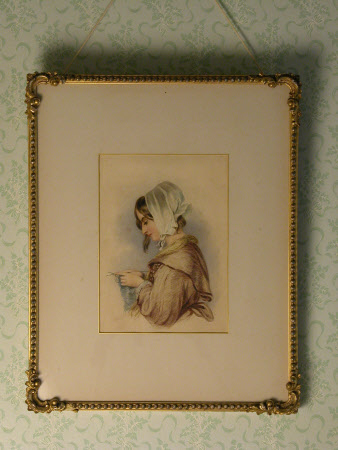The Marchioness of Abercorn at the Cottage of Industry
Sarah Biffin (c.1784 - 1850)
Category
Art / Drawings and watercolours
Date
1846 - 1850
Materials
Watercolour on paper
Measurements
430 mm (H); 380 mm (W)
Place of origin
Liverpool
Order this imageCollection
Llanerchaeron, Ceredigion
NT 461462
Caption
Sarah Biffin (or Beffin) was a celebrated disabled artist. She was born into a farming family in Somerset, where her creative life began at an early age. She taught herself to sew as a young child and became an accomplished dressmaker. Born without arms or legs, Biffin began painting lessons aged 20, using her mouth and shoulder to control the brush. She left home soon afterwards and began touring the country with her teacher, Mr Dukes. Biffin demonstrated sewing and painting for paying audiences, who received a sample of her writing to take away. This entrepreneurial spirit drove Biffin’s career and she experienced periods of considerable success. George Douglas, 16th Earl of Morton (1761–1827), became an important patron and introduced her to the miniature portrait artist William Marshall Craig (d.1827), who provided her with additional specialist training. Biffin moved between cities – including Brighton, Birmingham, Oxford and Cheltenham – undertaking commissions for clients, and offering lessons in lithography and miniature painting. In 1821 Biffin established her own studio on the Strand in London and was working mostly to commission for wealthy clients, describing herself in a newspaper advertisement as ‘the famous Miss Beffin, miniature painter of London’. That same year, she exhibited four miniatures at the Royal Academy of Arts, received a silver medal from the Royal Society of Arts, and was appointed as miniaturist to Willem Frederick, Prince of Orange-Nassau (1772–1843). In 1830 she was appointed as miniaturist to Princess Augusta Sophia (1768–1840), daughter of King George III. Following the death of the princess and a decline in the fashion for miniatures, Biffin struggled financially but did continue to work. She painted an affecting portrait of the Marchioness of Abercorn while based on Mount Pleasant in Liverpool. A public appeal to raise money to guarantee her an annual income was led by the Rathbone family of philanthropists and the collector Joseph Mayer. Almost 30 years after her first showing, Biffin exhibited once more at the Royal Academy, a few short months before her death in 1850.
Summary
Watercolour portrait of 19th century lady in a cap, facing left, knitting. Card mount, narrow gilded frame with beaded sides and attached foliate decoration at the corners, glazed. Entitled 'The Marchioness of Abercorn at the Cottage of Industry' by Miss Sarah Biffin, miniature portrait artist. Hand written receipt on reverse, dated Dec 1868, for £10 over a penny stamp. Also 'Miss Biffin, Painted without hands'
Full description
Sarah Biffin (1784-1850) was a celebrated female disabled artist. She painted this portrait of Louisa Jane Hamilton, Marchioness of Abercorn (1812-1905), between 1846-50 while based at premises on Mount Pleasant in Liverpool. Biffin was born to a farming family in Somerset. In her early life, she taught herself to sew and aged twenty began lessons in painting, leaving home to live with her teacher, Mr Dukes and his family. From about 1805, Biffin extensively toured the country with Dukes, demonstrating sewing, painting and writing for paying audiences who would receive a sample of her writing to take away with them. Biffin began to exhibit work in London galleries and established a studio on the Strand, working mostly to commission for clients. The Earl of Morton was an important patron and introduced Biffin to the established portrait artist William Marshall Craig, who provided her with additional training. Biffin exhibited at the Royal Academy of Arts in 1821 and was appointed as miniaturist to Willem Frederick, Prince of Orange. In 1830, she was appointed as miniaturist to Princess Augusta Sophia, daughter of King George III. Following the death of her royal patron and a decline in the fashion for miniatures, Biffin struggled financially. A public appeal to raise money to guarantee her an annual income was spearheaded by the Rathbone family of philanthropists in Liverpool and the collector Joseph Mayer. In 1850, she exhibited once more at the Royal Academy, shortly before her death.
Provenance
An item from the Llanerchaeron collection, left to the National Trust in the will of John Powell Ponsonby Lewes in 1989.
Marks and inscriptions
Verso, back of frame: 'Brickdale December the 8th 1868 Richard Sandbach Esq. Bought of Thos Whiteley / the picture painted by /Miss Biffin without hands / Subject Marchioness of / Abercorn, for the amount of / 10£ Settled Elizabeth Whiteley.' [hand written in cursive script on paper label, black ink] Verso, back of frame: CORRECT AND HIGHLY-FINISHED / LIKENESSES / TAKEN BY / MISS BIFFIN / (Without Hands,) / No. 32, Mount Pleasant, Liverpool [printed paper label, black ink] Verso, back of frame: MISS BIFFIN. / 20 The Marchioness of Abercorn at the Cottage of Industry / Painted without hands.
Makers and roles
Sarah Biffin (c.1784 - 1850), artist
References
Conroy, Rachel, Women Artists and Designers at the National Trust, 2025, pp. 114-115
